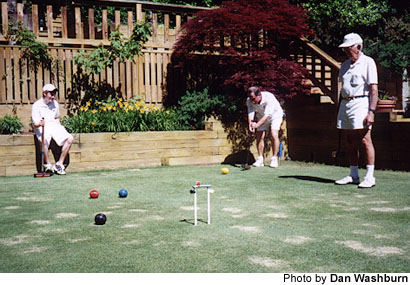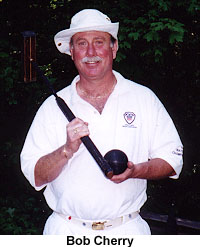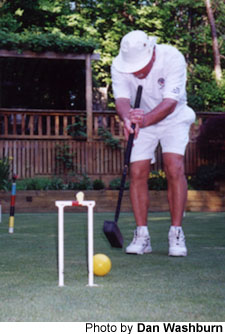
May 2, 2000 — I just finished playing my first game of croquet, and my head hurts. No, I was not struck with a mallet or plunked with a ball. It’s just that this sport can be quite complicated.
Three hours on the court, and I was both confused and captivated. My mind was a mess of rovers and roquets, deadness and aliveness, wickets and balls. But my body was determined to get that blue ball to roll straight — even if I wasn’t completely sure why I was aiming the way I was.
“Really, it’s not that complicated once you’ve played it,” my partner Bob Cherry assured me. “Trying to learn it for the first time, though, it’s overwhelming.” 
A combination of chess and billiards — if you can imagine strolling around on a giant billiards table — croquet requires serious strategy and perfect precision. A degree in physics wouldn’t hurt, either.
It is a sport steeped in tradition and governed by rules of etiquette, but play can be intense, cut-throat even. Well, as cut-throat as four adults wearing croquet whites on a manicured lawn can be.
Although we were playing on a court behind Cherry’s Dunwoody, Ga. home, this was not your common game of backyard croquet. For starters, the mallets were square, not round.
This is American six-wicket croquet. This is serious stuff.
“There’s a lot of thinking,” said Cherry, a board member of the Atlanta Mallet Club. “There’s a lot of strategy to it. But you pay dearly for your mistakes.”
Thankfully for Cherry, he doesn’t make many mistakes. The 50-year-old is one of the top croquet players in the United States and the reigning Georgia champion. One mistake Cherry did make on Sunday: He chose me as his playing partner.
Our opponents, 80-year-old Duane Hull of Stone Mountain, Ga. and 16-year-old Matt Gilbert of Duluth, Ga., had to like their chances.
Cherry’s court, by the way, is beautiful. He had it built just like a putting green, with drainage system and everything. There used to be dozens of trees where the court now is, and Cherry’s wife Carol admits to crying a bit when the loggers started logging.
“But I don’t regret it at all now,” said Carol, who has become just about as croquet crazy as her husband. The two have traveled to eight tournaments across the country already this year.
Bob picked up the sport about 10 years ago. He was hooked right away, he said.
“I decided I was going to really focus on something and try to get really good at it,” Cherry said. “It’s an obscure sport, sure. But it’s still fun to go to the national tournament, even if it’s an obscure sport.”
As in most sports, the basic objective of six-wicket croquet is relatively straightforward. In doubles, the first team to hit both of its balls through a course of 12 wickets — each wicket is used twice — and then into a stake at center court, wins.
I realized early on, however, that croquet is not so clear-cut. I hit three of my first four shots out of bounds. On purpose.
“This isn’t going to make sense initially,” Cherry said as he repeatedly instructed me to aim for the sideline. He was smiling.
In time, we began to hit the balls on the court instead of off. I was then introduced to more of croquet’s nuances. You earn extra shots by putting your ball through a wicket or striking it into another ball. But it must be the correct wicket (obviously, not the pioneer wicket) and it must be one of the correct balls (obviously, not a ball you are dead on). Please, don’t ask me to explain any of this.
As in billiards, with the right combination of ball placement and skill, a good player can run the court. Thus, bad players can do a lot of standing around, which eventually leads to sitting down. Let’s just say I had plenty of time to watch.
And watching is fun, if Cherry’s on the court. He makes it look easy. He would tell me what he was trying to do with his upcoming shot, and although I often had no idea what he was talking about, I was told that what he wanted to happen usually did. 
“All right,” he would say. “I’m going to kick this ball deep behind yellow so I can put it over to pioneer at two-back while I get to the yellow ball.”
Sure.
“OK, I’m going to send my pioneer to two-back and I’m going to stop near yellow so I can take yellow over near red and continue this break.”
Uh huh.
Whatever he did, it worked. And before I knew it, he had almost completed the course. One problem: His partner had yet to clear wicket No. 2.
That fact, I believe, caused Cherry’s head to hurt a bit, too.
